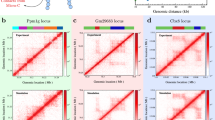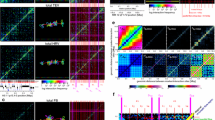Abstract
Coarse-grained models are used to assess the packing of the 30-nm chromatin fiber. First, rigid assembly models for nucleosomal repeats from 155 to 211 bp are built using the crystal structure of the mononucleosome and attached straight stretches of B-DNA. The resulting fiber conformations are analyzed for static clashes and classified into stable and unstable structures. The effect of flexibility and thermal fluctuations is then taken into account by conducting Monte Carlo simulations of chromatin fiber models. Here the DNA is approximated by a flexible polymer chain with Debye–Hückel electrostatics, the geometry of the linker DNA connecting the nucleosomes is based on a two-angle zigzag model, and nucleosomes are represented by flat ellipsoids interacting via an attractive Gay–Berne potential. Unstable fibers occur at a particular repeat length period of 10 bp. Also, the regions of densely compacted fibers repeat at intervals of 10 bp. Besides one- and two-start helical zigzag structures, we show evidence for possible three-start structures, which have not been reported in experiments yet. Finally, we show that a local opening of the linker DNA at the nucleosome core—as probably occurs upon histone acetylation—leads to more open and flexible structures.












Similar content being viewed by others
Abbreviations
- NCP:
-
Nucleosome core particle
- L p :
-
Persistence length
- MC:
-
Monte Carlo
References
Olins AL, Olins DE (1974) Spheroid chromatin units (v bodies). Science 183:330–332. doi:10.1126/science.183.4122.330
Kornberg RD (1974) Chromatin structure: a repeating unit of histones and DNA. Science 184:868–871. doi:10.1126/science.184.4139.868
Arents G, Burlingame RW, Wang B-C, Love WE, Moudrianakis EN (1991) The nucleosomal core histone octamer at 3.1 Å resolution: a triparatite protein assembly and a left-handed superhelix. Proc Natl Acad Sci USA 88:10148–10152. doi:10.1073/pnas.88.22.10148
Luger K, Mäder AW, Richmond RK, Sargent DF, Richmond TJ (1997) Crystal structure of the nucleosome core particle at 2.8 Å resolution. Nature 389:251–260. doi:10.1038/38444
van Holde KE (1989) Chromatin, Springer, Heidelberg
Finch JT, Klug A (1976) Solenoidal model for superstructure in chromatin. Proc Natl Acad Sci USA 73:1897–1901. doi:10.1073/pnas.73.6.1897
Thoma F, Koller T, Klug A (1979) Involvement of histone H1 in the organization of the nucleosome and of the salt-dependent superstructures of chromatin. J Cell Biol 83:403–427. doi:10.1083/jcb.83.2.403
McGhee JD, Nickol JM, Felsenfeld G, Rau DC (1983) Higher order structure of chromatin: orientation of nucleosomes within the 30 nm chromatin solenoid is independent of species and spacer length. Cell 33:831–841. doi:10.1016/0092-8674(83)90025-9
Widom J, Klug A (1985) Structure of the 300A chromatin filament: X-ray diffraction from oriented samples. Cell 43:207–213. doi:10.1016/0092-8674(85)90025-X
Woodcock CL, Frado LL, Rattner JB (1984) The higher-order structure of chromatin: evidence for a helical ribbon arrangement. J Cell Biol 99:42–52. doi:10.1083/jcb.99.1.42
Woodcock CL, Grigoryev SA, Horowitz RA, Whitaker N (1993) A chromatin folding model that incorporates linker variability generates fibers resembling the native structures. Proc Natl Acad Sci USA 90:9021–9025. doi:10.1073/pnas.90.19.9021
van Holde K, Zlatanova J (1996) What determines the folding of the chromatin fiber. Proc Natl Acad Sci USA 93:10548–10555. doi:10.1073/pnas.93.20.10548
Pehrson JR (1995) Probing the conformation of nucleosome linker DNA in situ with pyrimidine dimer formation. J Biol Chem 270:22440–22444
Prunell A (1998) A topological approach to nucleosome structure and dynamics: the linking number paradox and other issues. Biophys J 74:2531–2544. doi:10.1016/S0006-3495(98)77961-5
Bednar J, Horowitz RA, Grigoryev SA, Carruthers LM, Hansen JC, Koster AJ, Woodcock CL (1998) Nucleosomes, linker DNA, and linker histone form a unique structural motif that directs the higher-order folding and compaction of chromatin. Proc Natl Acad Sci USA 95:14173–14178. doi:10.1073/pnas.95.24.14173
Rydberg B, Holley WR, Mian IS, Chatterjee A (1998) Chromatin conformation in living cells: support for a zig–zag model of the 30 nm chromatin fiber. J Mol Biol 284:71–84. doi:10.1006/jmbi.1998.2150
Dorigo B, Schalch T, Kulangara A, Duda S, Schroeder RR, Richmond TJ (2004) Nucleosome arrays reveal the two-start organization of the chromatin fiber. Science 306:1571–1573. doi:10.1126/science.1103124
Schalch T, Duda S, Sargent DF, Richmond TJ (2005) X-ray structure of a tetranucleosome and its implications for the chromatin fibre. Nature 436:138–141. doi:10.1038/nature03686
Makarov V, Dimitrov S, Smirnov V, Pashev I (1985) A triple helix model for the structure of chromatin fiber. FEBS Lett 181:357–361. doi:10.1016/0014-5793(85)80292-1
Beard DA, Schlick T (2001) Computational modeling predicts the structure and dynamics of chromatin fiber. Structure 9:105–114. doi:10.1016/S0969-2126(01)00572-X
Wedemann G, Langowski J (2002) Computer simulation of the 30-nanometer chromatin fiber. Biophys J 82:2847–2859. doi:10.1016/S0006-3495(02)75627-0
Engelhardt M (2007) Choreography for nucleosomes: the conformational freedom of the nucleosomal filament and its limitations. Nucleic Acids Res 35:e106. doi:10.1093/nar/gkm560
Langowski J, Schiessel H (2004) Theory and computational modeling of the 30 nm chromatin fiber. In: Zlananova J, Leuba SH (eds) Chromatin structure and dynamics: state-of-the-art. Elsevier, Amsterdam, pp 397–420
Beard DA, Schlick T (2001) Modeling salt-mediated electrostatics of macromolecules: the discrete surface charge optimization algorithm and its application to the nucleosome. Biopolymers 58:106–115. doi:10.1002/1097-0282(200101)58:1<106::AID-BIP100>3.0.CO;2-#
Dorigo B, Schalch T, Bystricky K, Richmond TJ (2003) Chromatin fiber folding: requirement for the histone H4N-terminal tail. J Mol Biol 327:85–96. doi:10.1016/S0022-2836(03)00025-1
Davey CA, Sargent DF, Luger K, Maeder AW, Richmond TJ (2002) Solvent mediated interactions in the structure of the nucleosome core particle at 1.9 a resolution. J Mol Biol 319:1097–1113. doi:10.1016/S0022-2836(02)00386-8
Widom J (1992) A relationship between the helical twist of DNA and the ordered positioning of nucleosomes in all eukaryotic cells. Proc Natl Acad Sci USA 89:1095–1099. doi:10.1073/pnas.89.3.1095
Aumann F, Lankas F, Caudron M, Langowski J (2006) Monte Carlo simulation of chromatin stretching. Phys Rev E Stat Nonlin Soft Matter Phys 73:041927. doi:10.1103/PhysRevE.73.041927
van Holde K, Zlatanova J (1995) Chromatin higher order structure: chasing a mirage? J Biol Chem 270:8373–8376. doi:10.1074/jbc.270.15.8373
Robinson PJ, Fairall L, Huynh VA, Rhodes D (2006) EM measurements define the dimensions of the “30-nm” chromatin fiber: evidence for a compact, interdigitated structure. Proc Natl Acad Sci USA 103:6506–6511. doi:10.1073/pnas.0601212103
Karpov VL, Bavykin SG, Preobrazhenskaya OV, Belyavsky AV, Mirzabekov AD (1982) Alignment of nucleosomes along DNA and organization of spacer DNA in Drosophila chromatin. Nucleic Acids Res 10:4321–4337. doi:10.1093/nar/10.14.4321
Lohr D, Van Holde KE (1979) Organization of spacer DNA in chromatin. Proc Natl Acad Sci USA 76:6326–6330. doi:10.1073/pnas.76.12.6326
Lohr D (1986) The salt dependence of chicken and yeast chromatin structure. Effects on internucleosomal organization and relation to active chromatin. J Biol Chem 261:9904–9914
Strauss F, Prunell A (1983) Organization of internucleosomal DNA in rat liver chromatin. EMBO J 2:51–56
Drew HR, Calladine CR (1987) Sequence-specific positioning of core histones on an 860 base-pair DNA. Experiment and theory. J Mol Biol 195:143–173. doi:10.1016/0022-2836(87)90333-0
Hayes JJ, Tullius TD, Wolffe AP (1990) The structure of DNA in a nucleosome. Proc Natl Acad Sci USA 87:7405–7409. doi:10.1073/pnas.87.19.7405
Bavykin SG, Usachenko SI, Zalensky AO, Mirzabekov AD (1990) Structure of nucleosomes and organization of internucleosomal DNA in chromatin. J Mol Biol 212:495–511. doi:10.1016/0022-2836(90)90328-J
Hayes JJ, Clark DJ, Wolffe AP (1991) Histone contributions to the structure of DNA in the nucleosome. Proc Natl Acad Sci USA 88:6829–6833. doi:10.1073/pnas.88.15.6829
Widom J, Finch JT, Thomas JO (1985) Higher-order structure of long repeat chromatin. EMBO J 4:3189–3194
Horowitz RA, Agard DA, Sedat JW, Woodcock CL (1994) The three-dimensional architecture of chromatin in situ: electron tomography reveals fibers composed of a continuously variable zig–zag nucleosomal ribbon. J Cell Biol 125:1–10. doi:10.1083/jcb.125.1.1
Leuba SH, Yang G, Robert C, Samori B, van Holde K, Zlatanova J, Bustamante C (1994) Three-dimensional structure of extended chromatin fibers as revealed by tapping-mode scanning force microscopy. Proc Natl Acad Sci USA 91:11621–11625. doi:10.1073/pnas.91.24.11621
Woodcock CL, Dimitrov S (2001) Higher-order structure of chromatin and chromosomes. Curr Opin Genet Dev 11:130–135. doi:10.1016/S0959-437X(00)00169-6
Schiessel H, Gelbart WM, Bruinsma R (2001) DNA folding: structural and mechanical properties of the two- angle model for chromatin. Biophys J 80:1940–1956. doi:10.1016/S0006-3495(01)76164-4
Luger K (2003) Structure and dynamic behavior of nucleosomes. Curr Opin Genet Dev 13:127–135. doi:10.1016/S0959-437X(03)00026-1
Bennink ML, Leuba SH, Leno GH, Zlatanova J, de Grooth BG, Greve J (2001) Unfolding individual nucleosomes by stretching single chromatin fibers with optical tweezers. Nat Struct Biol 8:606–610. doi:10.1038/89646
Brower-Toland B, Wacker DA, Fulbright RM, Lis JT, Kraus WL, Wang MD (2005) Specific contributions of histone tails and their acetylation to the mechanical stability of nucleosomes. J Mol Biol 346:135–146. doi:10.1016/j.jmb.2004.11.056
Pope LH, Bennink ML, van Leijenhorst-Groener KA, Nikova D, Greve J, Marko JF (2005) Single chromatin fiber stretching reveals physically distinct populations of disassembly events. Biophys J 88:3572–3583. doi:10.1529/biophysj.104.053074
Cairns BR (2007) Chromatin remodeling: insights and intrigue from single-molecule studies. Nat Struct Mol Biol 14:989–996. doi:10.1038/nsmb1333
Yan J, Maresca TJ, Skoko D, Adams CD, Xiao B, Christensen MO, Heald R, Marko JF (2007) Micromanipulation studies of chromatin fibers in Xenopus egg extracts reveal ATP-dependent chromatin assembly dynamics. Mol Biol Cell 18:464–474. doi:10.1091/mbc.E06-09-0800
Zinchenko AA, Sakaue T, Araki S, Yoshikawa K, Baigl D (2007) Single-chain compaction of long duplex DNA by cationic nanoparticles: modes of interaction and comparison with chromatin. J Phys Chem B 111:3019–3031. doi:10.1021/jp067926z
Acknowledgment
This work was supported by the initiative of the VW foundation ‘Physics, Chemistry, and Biology with single molecules’.
Author information
Authors and Affiliations
Corresponding author
Additional information
Dedicated to Professor Sandor Suhai on the occasion of his 65th birthday and published as part of the Suhai Festschrift Issue.
F. Aumann and J. Sühnel contributed equally.
Electronic supplementary material
Below is the link to the electronic supplementary material.
Rights and permissions
About this article
Cite this article
Aumann, F., Sühnel, J., Langowski, J. et al. Rigid assembly and Monte Carlo models of stable and unstable chromatin structures: the effect of nucleosomal spacing. Theor Chem Acc 125, 217–231 (2010). https://doi.org/10.1007/s00214-009-0561-9
Received:
Accepted:
Published:
Issue Date:
DOI: https://doi.org/10.1007/s00214-009-0561-9




